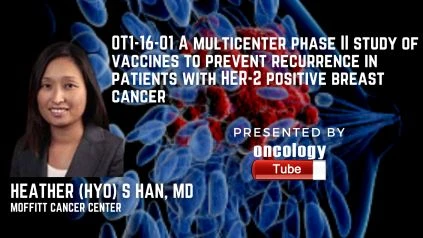Dr. Heather Han is a medical oncologist and the Research Director of the Moffitt Cancer Center’s Department of Breast Oncology. She is committed to finding a cure for the millions of women whose lives have been impacted by a breast cancer diagnosis. In this video Dr. Han speaks on the OT1-16-01 A multicenter phase II study of vaccines to prevent recurrence in patients with HER-2 positive breast cancer.
Abstract-
The maximum limit of the Disclosure Block has been reached.
Background: In patients with early-stage TNBC, KEYNOTE-522 (NCT03036488) is a phase 3 study comparing neoadjuvant pembro + chemo to placebo Plus chemo, followed by adjuvant pembro vs placebo. The
The primary analysis revealed a statistically significant and clinically significant improvement in the number of events-free days.
EFS with pembro + chemo and then pembro. To determine the reliability and consistency of
The primary EFS result was analyzed, as well as sensitivity and subgroup analyses for EFS.
Patients with previously untreated, non-metastatic, centrally confirmed TNBC (stage T1c N1-2) were included in the study.
or T2-4 N0-2 as defined by the AJCC) were randomly assigned to receive pembro 200 mg Q3W or placebo, both administered with 4 hours of rest.
4 rounds of doxorubicin or epirubicin + cyclophosphamide followed by 4 cycles of paclitaxel + carboplatin
(phase neoadjuvant) Patients were given pembro or placebo for 9 cycles after definitive surgery, or until the end of the study.
a recurrence or a level of toxicity that is intolerable (adjuvant phase). Patients were divided into two groups based on their nodal status (positive or negative).
tumor size (T1/T2 or T3/T4), and carboplatin treatment schedule (Q3W or QW). Primary and secondary
The pCR rate and EFS are the endpoints. EFS was subjected to five different sensitivity studies, each with its own set of parameters.
2 that looked at the effects of various censorship rules, and 3 that looked at the effects of various events
definitions. The effects of treatment on EFS were investigated in patient subgroups defined by nodal status.
Menopausal state (pre-menopausal or postmenopausal), HER2 status (2+ by IHC but FISH- or 0-1+ by IHC), and LDH (>ULN or ULN) are also factors to consider.
Results: Of the 1174 patients who were randomly assigned, 784 were assigned to the pembro + chemo group.
390 people were allocated to the placebo + chemo group at random. At the time of the study, the median follow-up was 39.1 months.
the data cutoff date of March 23, 2021 The advantages of neoadjuvant pembro + chemo followed by neoadjuvant pembro + chemo
The key EFS outcomes for adjuvant pembro vs. neoadjuvant chemo alone were fairly consistent.
each of the five sensitivity analyses, as well as each subgroup’s evaluation (Table).
Conclusion: EFS sensitivity studies reveal that neoadjuvant pembro + chemo has a strong therapeutic benefit.
For previously untreated non-metastatic TNBC, adjuvant pembro is used. This was a common benefit.
Across a wide range of patient categories, the results are consistent.

